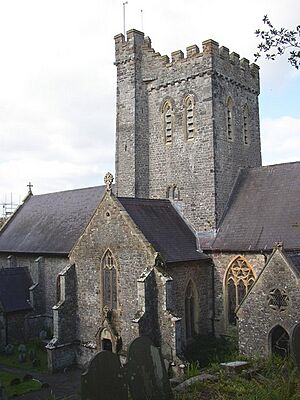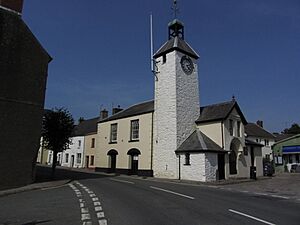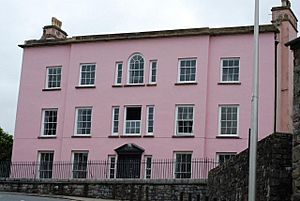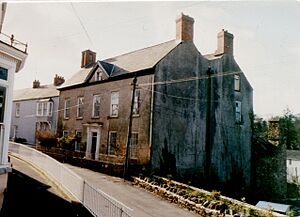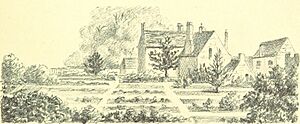Laugharne facts for kids
Quick facts for kids Laugharne
|
|
|---|---|
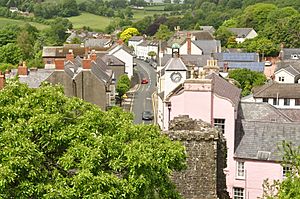 Laugharne from the castle |
|
| Population | 1,222 |
| OS grid reference | SN301109 |
| Community |
|
| Principal area | |
| Ceremonial county | |
| Country | Wales |
| Sovereign state | United Kingdom |
| Post town | CARMARTHEN |
| Postcode district | SA33 |
| Dialling code | 01994 |
| Police | Dyfed-Powys |
| Fire | Mid and West Wales |
| Ambulance | Welsh |
| EU Parliament | Wales |
| UK Parliament |
|
Laugharne (pronounced Larn) is a small town located on the south coast of Carmarthenshire, Wales. It sits right on the estuary of the River Tâf, where the river meets the sea.
Laugharne is special because it has a very old and unique local government called the Laugharne Corporation. This group has been running the town for hundreds of years! The town is mostly English-speaking, even though it's in Wales. In 2021, about 1,100 people lived here.
The famous Welsh poet Dylan Thomas lived in Laugharne from 1949 until he passed away in 1953. He loved the town and once called it a "timeless, mild, beguiling island of a town." Many people believe Laugharne was the inspiration for the fictional town of Llareggub in his famous play, Under Milk Wood.
Contents
Laugharne's Long History

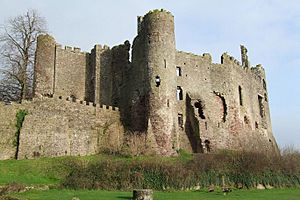
Laugharne has been home to people for a very long time. Over 50,000 years ago, hunter-gatherers used a natural cave at Coygan Bluff as a temporary shelter. Later, people from the Mesolithic and Neolithic periods also lived here. This makes Laugharne one of the oldest places in Wales where people have continuously lived!
Around 400 BC, during the Bronze Age, a fort was built on top of Coygan hill. People also lived in open settlements and had special burial sites nearby. Later, during the Roman times, the area continued to be an important settlement. Many Roman coins and valuable items from the 6th century have been found here.
In the Early Middle Ages, Laugharne was a main settlement. It was part of the Kingdom of Dyfed, a powerful Welsh kingdom. In 1093, the Normans took control of this area.
The Castle's Story
In 1116, a Norman knight named Robert Courtemain built a castle at Laugharne. It was first known as Abercorran Castle. Over the years, the castle was owned by different powerful families.
One important owner was Guy de Bryan, whose family held the castle for many years. Later, in 1575, Queen Elizabeth I gave the castle to Sir John Perrot. During the English Civil War in 1644, the castle was used by the king's soldiers. It was then captured by Major-General Rowland Laugharne, which left it in ruins.
Laugharne Corporation: A Unique Government
Laugharne has a very special local government called the Laugharne Corporation. It's one of the last surviving mediæval (Middle Ages) corporations in the United Kingdom, like the City of London Corporation. It was started in 1291 by Sir Guy de Brian.
The Corporation is led by the portreeve, who wears a special chain of gold cockle shells. Each new portreeve adds a shell with their name and date. The portreeve is chosen every year.
This Corporation used to handle local legal cases and manage the town's common lands. Laugharne still uses an open-field system for farming, which is a very old way of sharing land. It's one of only two places in Britain that still does this! The most senior 76 burgesses (town members) get a strip of land on a hill called Hugdon for life.
At the Portreeve's feast, they make a toast to "the immortal memory of Sir Guido de Brian" and sing a song about how he divided the land.
Local Government Today
Since 1972, the Laugharne Township Community Council has been the local government for the town. It has 11 community councillors who help run local services.
For bigger elections, Laugharne is part of the Laugharne Township electoral ward. This ward also includes three nearby communities and is represented by one county councillor on the Carmarthenshire County Council.
St Martin's Church
The local church, St Martin's, was built in the 14th century by Guido de Brian. Inside the church, there's a special stone slab from the 9th or 10th century with a carved Celtic design. Some people think the design might even be from the Vikings!
The churchyard is famous because it's where the poet Dylan Thomas is buried. His grave is marked by a simple white cross.
Things to See in Laugharne
Laugharne has many interesting places to visit. You can explore the 12th-century Laugharne Castle and see the Laugharne Town Hall. The estuary is also a great place to watch different kinds of birdlife.
The town has 69 listed buildings, which means they are important for their history or architecture. You can see beautiful Georgian townhouses like The Great House and Castle House. Island House has parts that date back to the Tudor period.
For fans of Dylan Thomas, there are several landmarks. You can visit the Dylan Thomas Boathouse, where he lived with his family. It's now a museum. You can also see his writing shed and walk the "Dylan Thomas Birthday Walk," which inspired one of his poems.
Laugharne Weekend Festival
The Laugharne Weekend is a fun arts festival that happens every spring. It started in 2007 and brings together writers, musicians, and performers. Famous people like Ray Davies and Patti Smith have performed there. The main events are held at the Millennium Hall, with smaller events at places like the Dylan Thomas Boathouse.
Famous People from Laugharne
Many interesting people have connections to Laugharne:
- Sir John Perrot (1528–1592) was a powerful politician who lived in Laugharne Castle.
- Rowland Laugharne (1607–1675) was a general during the English Civil War.
- Mary Wollstonecraft (1759–1797), a famous writer and advocate for women's rights, lived in Laugharne as a child.
- Richard Hughes (1900–1976), a writer, lived at Castle House and helped Dylan Thomas move to Laugharne.
- Dylan Thomas (1914–1953), the famous poet, lived and is buried here.
- Sir Kingsley Amis (1922–1995), a well-known novelist, wrote one of his award-winning books while living in Laugharne.
Images for kids
See also
 In Spanish: Laugharne para niños
In Spanish: Laugharne para niños



